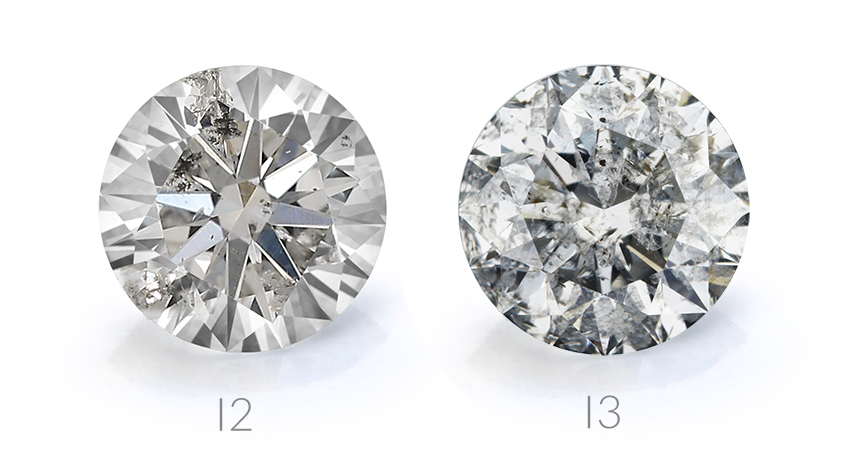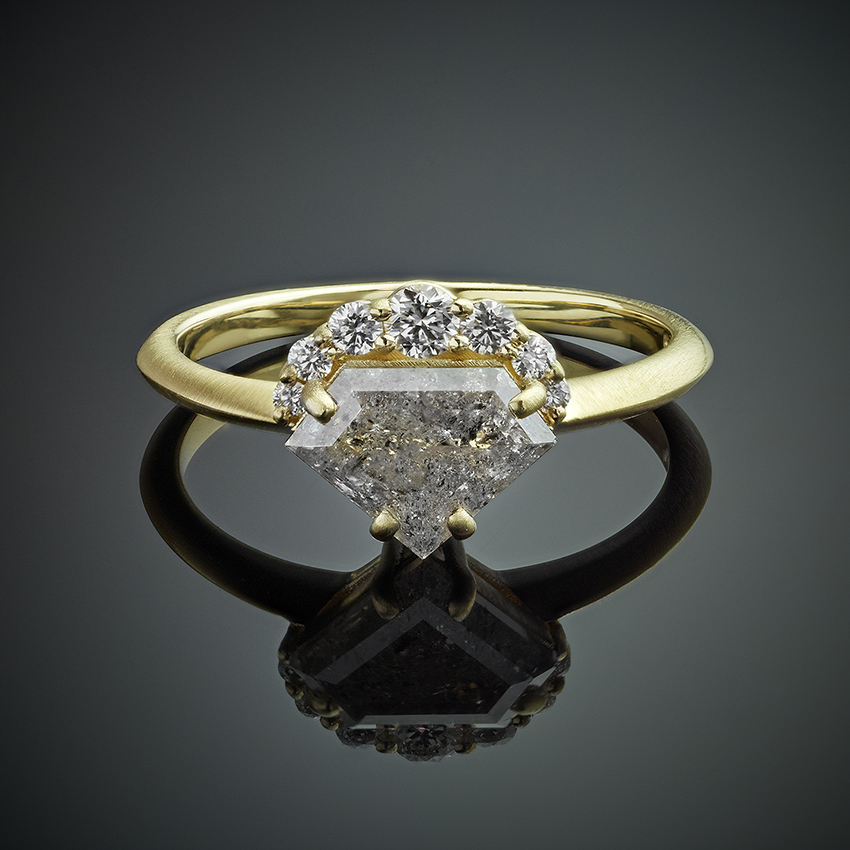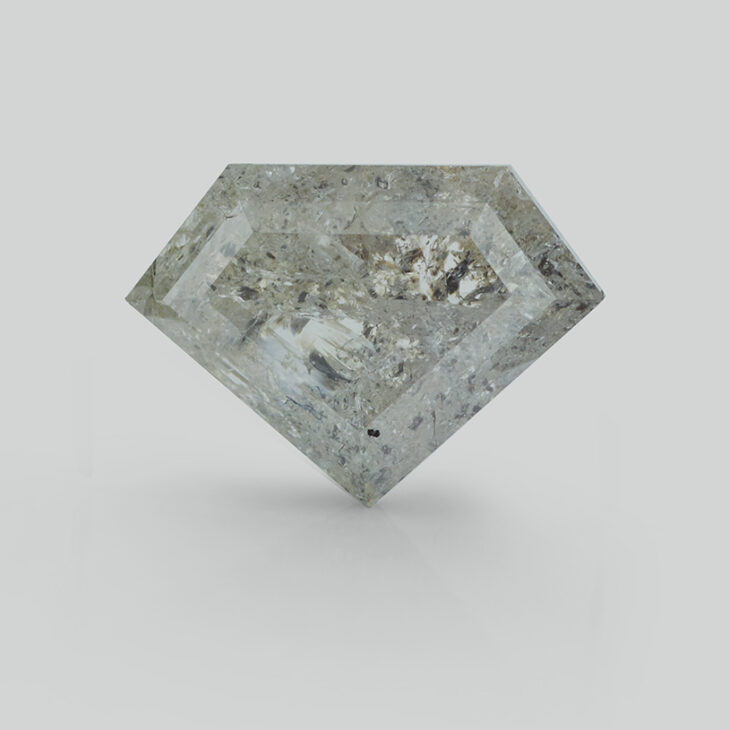I3 diamond clarity means “Included in the 3rd degree”.
Is I3 diamond clarity good?
I3 diamond clarity represents the lowest grade of diamond clarity available.
Firstly, the letter ‘I’ stands for ‘inclusion’. Next, the proceeding number ‘3’ represents the third and lowest clarity grade that any included diamond can achieve.
By comparison, I2 clarity diamonds are less included, and I1 clarity diamonds are even higher in clarity.
How clear is an I3 diamond?
I3 diamonds are not clear at all. They lack the desired clear appearance most buyers aspire to when purchasing a diamond.
To elaborate, I1 clarity diamonds feature fewer visible inclusions than I2 clarity diamonds and I3 clarity diamonds.
To gain a broader understanding of clarity grades, the following scale shows the full range of available clarity grades.

Diamond clarity chart showing the different diamond clarity grades
As clarity improves, we move up to slightly included (SI) and very slightly included (VVS) grades, until we reach the Internally Flawless (IF) and Flawless (FL) clarity grades.
Included-3 clarity represents the lowest official clarity grade for a diamond. However, huge differences exist between all available diamonds graded at this clarity level.

Example of a diamond at the very lowest clarity grade possible. Notice how little light passes through the diamond without affecting its overall sparkle.
The problem with I3 diamond clarity
Besides highly visible inclusions, there is an issue with I3 clarity diamonds. Since I3 represents the worst clarity, it covers a multitude of sins.
Two diamonds of I3 clarity can differ greatly. For this reason, some jewellery manufacturers invented grades—for example, I4, I5, I6, I7, etc. But the GIA clarity scale ends at I3 for the lowest possible diamond clarity.

How much do I3 clarity diamonds cost?
Expect a much lower cost when you purchase an I3 clarity diamond. Heavy inclusions can be white or black. Or, I3 diamonds may appear consistently opaque, cloudy, or bluff in appearance. Included diamonds are more plentiful. For this reason, prices are far lower.
All included diamonds feature a variety of inclusion types, ranging from feathers to crystals.
The only way the lowest-clarity diamonds are further reduced in value is through their carat weight, colour grade, and cut.
Prices vary considerably due to the significant difference in the clarity of the lowest diamonds. For example, a 1-carat diamond might cost between £800 and £ 1,500.
Fashionable, trending diamond styles.
One of the recent I3 clarity diamond trends relates to ‘Salt and Pepper Diamonds.’ The name applies to very low-clear diamonds with a speckled arrangement of black and white inclusions. Their lower cost makes this diamond attractive.

Unique I3 clarity diamond ring created through our bespoke jewellery design service.
Over the last decade, demand for Salt and Pepper diamonds skyrocketed. But at the same time, such diamonds prove that low-quality diamonds can be extremely fashionable.
Other examples include natural fancy-coloured diamonds. From experience, many of the rarest intensely coloured diamonds exhibit heavy inclusions. Moreover, their colour determines their rarity and value.
At Serendipity Diamonds, we recommend SI2 as a minimum clarity grade. At this grade, diamonds appear eye-clean. Below SI2 clarity, expect to see noticeable inclusions. Do not mistake I3 clarity for Si3 clarity—an unofficial grade falling between SI2 and I1 clarity.
If you buy an I3 diamond, heavy inclusions reduce the amount of light passing through the diamond. As a result, the stone will have reduced brilliance. In addition, there will be an increased risk of damage during setting.
Inclusions breaking the surface increase the risk of cleavage from pressure applied during setting.
One of our recent YouTube videos shows one of our finished jewellery commissions. Notice how the ring contrasts white, brilliant-cut, high-clarity diamonds with the shield-shaped salt-and-pepper diamond.
Lower-clarity diamonds without noticeable inclusions.
Some of the lowest-clarity diamonds show no visible inclusions. In this situation, instead of a dense arrangement of clarity characteristics, a diamond may appear dull, foggy and lifeless. This is due to an even distribution of inclusions that are dispersed evenly throughout the diamond. For more information, see our alternative post on milky and cloudy diamonds.
Price alternatives to low-clarity diamonds.
Many buyers choose a low-clarity diamond because of its lower price. In recent years, we introduced a new alternative to our collections.
For the same price as a low-clarity natural diamond, buyers can arrange a higher-clarity lab-grown diamond for the same cost.
As a rule of thumb, expect to pay around half the price for a lab-grown diamond compared to a natural diamond. For this reason, lab diamonds make an attractive choice by comparison.
Alternatively, non-carbon-based Moissanite provides a further choice and makes a popular alternative to diamonds with similar hardness and optical properties.
Do I3 lab-grown diamonds exist?
Yes. I3 lab-created diamonds exist, but there is little demand for I3 man-made diamonds. This is because the cost of a high-clarity lab-created diamond is equivalent to an I3 natural diamond.
About Mark Johnson
Mark founded Isle of Wight jewellers Serendipity Diamonds in 2007 after a career on the polished diamonds industry. Today he works in the Serendipity showroom, helping clients with jewellery, creating handmade designs and updating their two jewellery websites SerendipityDiamonds.com and Isle-of-Wight-Jewellery.co.uk



